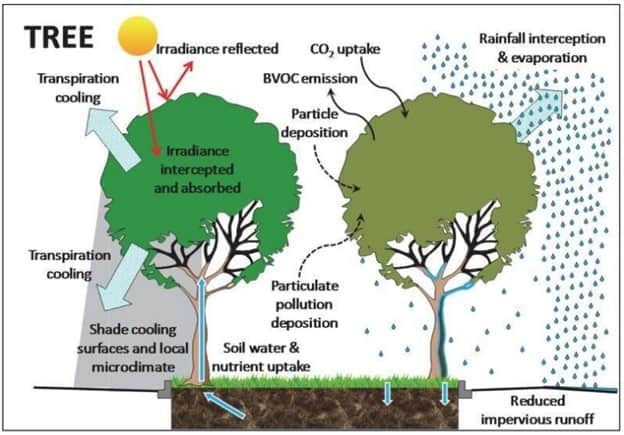City Forest Credits is proud to be part of the Smart Surfaces Coalition, a group of more than 40 organizations dedicated to creating cooler, healthier and more resilient cities.
What are Smart Surfaces?
Smart Surfaces offer an integrated city-wide strategy to actively manage sun and rain with reflective (cool) roofs and pavements, porous surfaces, green roofs, solar photovoltaic (PV), trees, rain gardens, and combinations of these surfaces. As climate change continues to plague cities with record weather events, now more than ever, investing in Smart Surfaces is key to resilience.1 Read more at the Smart Surfaces Coalition website.
Urban forests are one important piece of the smart surfaces puzzle.

Trees and forests in cities have acquired greater significance as “green infrastructure” due to the many city services they provide. As shown in the graphic above, trees help to cool their surrounding environment by releasing moisture into the air we breathe, a process referred to as transpiration. Trees shade buildings, streets, and sidewalks, contributing to a cooler microclimate that enhances city dwellers’ comfort and lowers energy bills. Trees also absorb and reflect radiation that would otherwise be more fully absorbed by dark urban surfaces, resulting in higher temperatures. These three ecosystem services – transpiration, shade, and reflection – reduce the urban heat island effect.
Additionally, trees help to manage stormwater runoff. They reduce stormwater by absorbing rainfall through their canopies and roots during storm events that would otherwise funnel into city drains. This reduces sewer and urban waterway flooding, which ultimately saves the city, and therefore taxpayers’, money.
Trees also help reduce pollution. There are many pollutants in urban environments due to high concentrations of fossil fuel use and industry. Trees clean the air that we breathe, removing ozone, nitrogen dioxide, sulfur dioxide, and particulate matter from the air. Trees also release oxygen into the air, further enhancing health and wellbeing.
The unique value of urban forest carbon credits.
Trees are key components in creating resilient cities given the ecosystem and community health benefits they provide. Proximity to urban forests is linked to better health outcomes in communities, less money spent on healthcare, higher birth rates, and reduced crime. Urban forest carbon projects provide an opportunity to invest in tree plantings in historically underserved communities. Tree planting and stewardship efforts bring together individuals and groups from many parts of a community. Additionally, urban forest projects are implemented by partners interested in trees’ long-term survival and direct, tangible benefits to the people that live near them, rather than harvesting the trees for timber.
Though the benefits of urban trees outweigh the costs, there is not currently enough funding for long-term care of these trees. One solution to the funding problem is verified urban forest carbon credits. These credits allow for a steady stream of revenue to provide long-term maintenance and stewardship services as well as to purchase more trees for continued planting in the future. Urban forest credits are unique in that they are not only important for the carbon they store, valued at $14.3 billion, but also for the myriad of co-benefits discussed above, which benefit the public. Protecting and planting urban forests will benefit millions of Americans, improving their health and well-being while also providing local climate action opportunities. These carbon credits ensure that as cities and urban areas expand, easily accessible green space will exist within them for years to come.
City Forest Credit’s (CFC) carbon crediting process offers a systems and accountability approach that ensure high-quality urban forest projects. Though CFC’s carbon credits generate long-term funding for projects that preserve and plant trees, they also ensure responsibility, accountability, and reported results. CFC works with participating entities, such as nonprofits and city governments, to make sure that all carbon projects pass validation and third-party verification. CFC also monitors projects over their 26-year lifetimes, further adding to the longevity and credibility. Companies can buy these locally sourced credits, investing more where people live, work, and recreate.
CFC is excited to be a part of the Smart Surfaces Coalition, providing training and education for metropolitan areas on the opportunity to leverage funding for urban trees. Urban forest credits will help municipalities reduce peak summer temperatures, reduce energy demand thereby lowering energy bills, improve health, air quality, and strengthen local economies. It is imperative that we accomplish the adoption of Smart Surfaces to meet each participating community’s goals and spur future smart surface action in new municipalities.
Interested in starting a carbon project?
Contact us: info@cityforestcredits.org
Sources
- Smart Surfaces Coalition. (2022, October 11). Smart Surfaces Coalition. https://smartsurfacescoalition.org/
